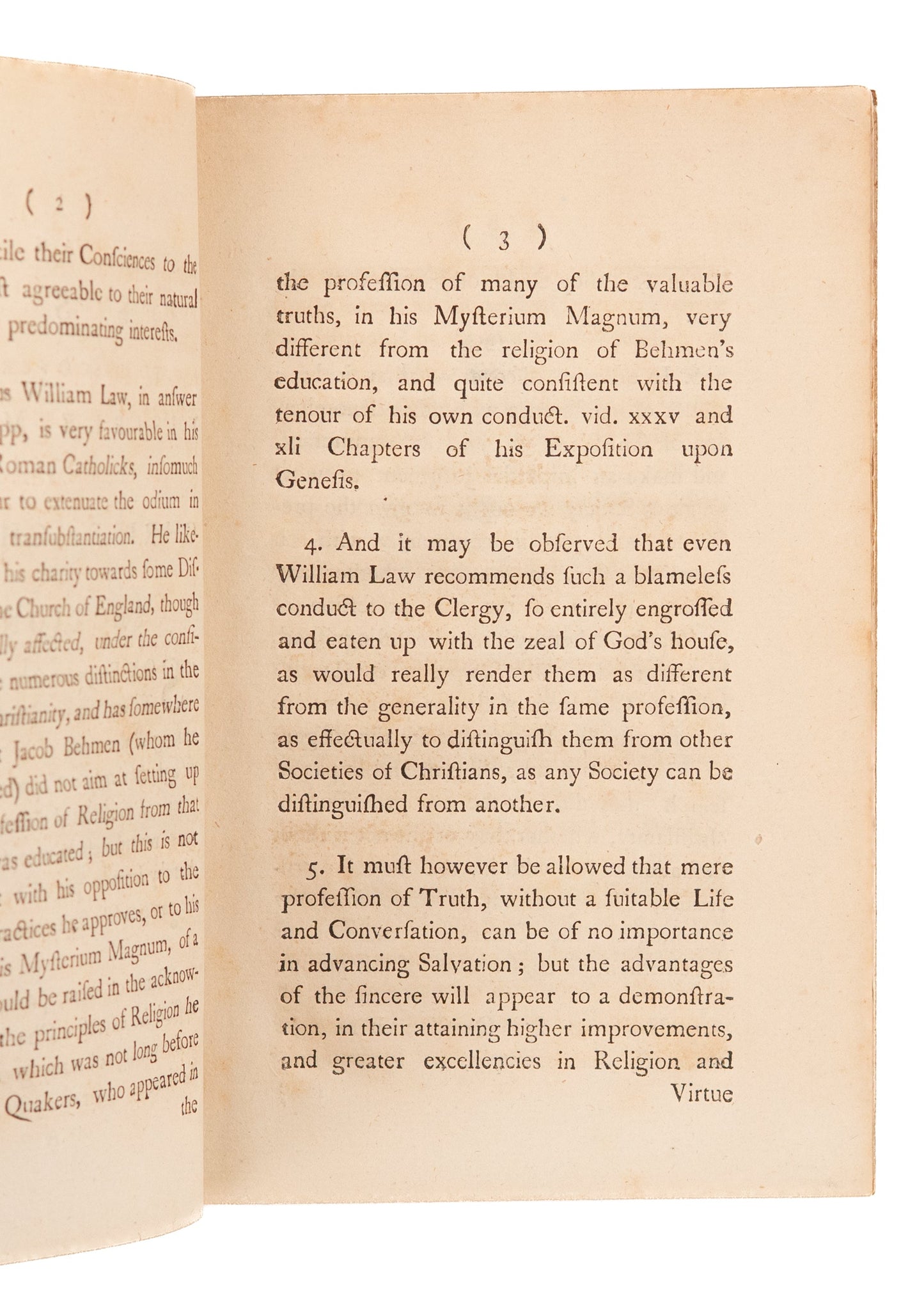Specs Fine Books
1779 WILLIAM CLARK. The Visible Marks of Christ's Spiritual Church. Owned by First Conscientious Objectors in America.
1779 WILLIAM CLARK. The Visible Marks of Christ's Spiritual Church. Owned by First Conscientious Objectors in America.
Couldn't load pickup availability
A fascinating little piece of Americana, written during the American Revolution, argues "The Spoils of Warefare to Maintain, Require the Power they did to Gain," as Quaker / Christian rational for a Christian-Pacificism during the War. This copy owned by the first Conscientious Objectors in America!
The work itself was written by prominent Quaker Physician, William Clark. Born in 1698, Clark was educated at Leyden [1727] and first practiced in London from 1728-1747. He then returned to his hometown in Bradford, practicing there until 1772. Upon his retirement, he moved to Colchester and gave himself exclusively to religious work until his death, c.1779.
In the medical field, he published three works:
1. Effects of the Passions on Human Bodies. [1727]
2. Medical Dissertation concerning the Effects of the Passions on Human Bodies. [An expanded edition of the Above, 1753]
3. The Province of Midwives in the Practice of their Art, instructing them in the timely knowledge of such difficulties as require the timely assistance of Men for the Preservation of Mother and Child. [1751]
Clark was a man of some prominence among the Friends. We read in the correspondence between James Logan and Thomas Story [1724-1741] in a letter from 1738 or 1739 that Story has consulted our William Clark as a man of piety and scientific learning with regard to a work he was writing, i.e. what sounds as though it would have been a fascinating publication.* Story notes that he is a prominent person of learning, and mentions him alongside sending the same manuscript to Fothergill.
So first, our present work is a fascinating and rather scarce Quaker tract on the nature of the true Church and how that manifests itself visibly. He discusses the Anglican and Catholic churches, Moravians, Presbyterians, Lutherans and Calvinists, Baptists, etc. The end is rather beautiful [if a bit dualistic]; he argues that one true distinguishing mark of the visible church, is the absence of all forms, including writ prayers and programmed services, and a waiting on the Spirit to illumine and lead every service, etc.
The provenance is even better than the work. At the title head is a simple inscription, "J. P. to James Pemberton.
James Pemberton [1723-1809] was a prominent Quaker in the city of Philadelphia. He was one of the earliest and most vocal advocates for the rights of Native Americans and 1790 was President of the Pennsylvania Abolition Society, the first abolitionist society in America. So strong were his convictions that he resigned from the Pennsylvania Assembly in 1756 when war was declared by the State against the Delaware Indians. A year later, he wrote a work directed toward Quakers, reminding them that the Kingdom of God and its way of advancing stood atop the Government's and that their allegiance was first to Christ and only second to the Nation.
As the American Revolution began to take shape, he refused to fight, making him perhaps America's first conscientious objector. He, along with 20 other Quakers, were banished to Winchester, Virginia under completely false accusations that qualified them for the banishment policy established by the Second Continental Congress. They were accused of having "Loyalist" sympathies. There was no evidence to support this, but instead, a simple line of logic that could not comprehend an alternative was argued to convict them. In the mind of their accusers, nothing mattered more than the Religious and Political Liberty of America. and Religious and Political Liberty must be acquired by the State. So, if someone refused to participate in that State-run military action, they must be opposed to the Religious and Political Liberty of America . . . which made them a Loyalist by default.
The J.P. of the inscription would be James' younger brother, John Pemberton [1727-1795]. He took after his brother and was active in Native American Affairs, being one of the brokers of the peace at the end of the War with the Delaware. He also was exiled to Winchester in 1777 for "treason" and being a "loyalist." Unlike his brother, James, who was a merchant, John was a minister, traveling with John Churchman on his preaching tours of England, Wales, and Cornwall, etc. .
The themes of disassociation from covenants and agreements that lead one to act unlike Christ to achieve the outcome of Christ, i.e. governmental power, military power, etc., i.e. present here are the same ideas that led to the Pemberton's conscientious objection of the American Revolution. A wonderful little item.
Clark, William M.D. An Essay to Discover the Visible Marks of Christ's Church, According to the Testimony of Holy Writ. Colchester: Printed by W. Keymer. 1779. 44pp.
Textually very crisp and clean. Apparently lacking a drawing of Clark present in some copies as a frontis. Removed form a larger sammelband at some point.
Share














